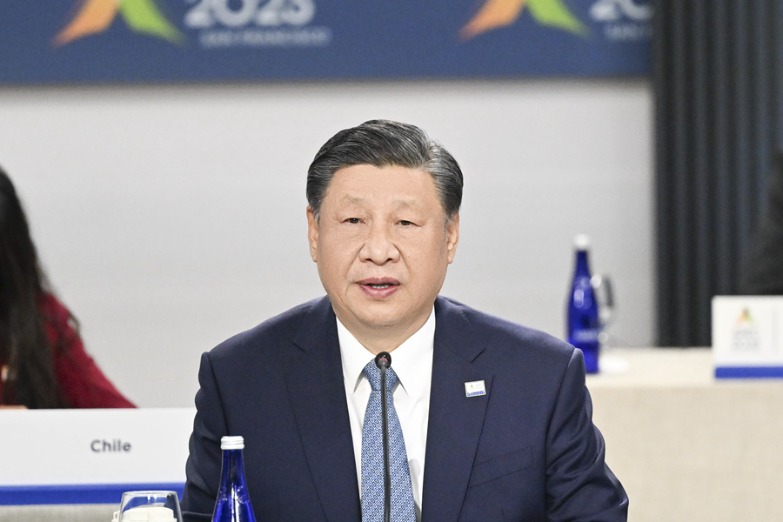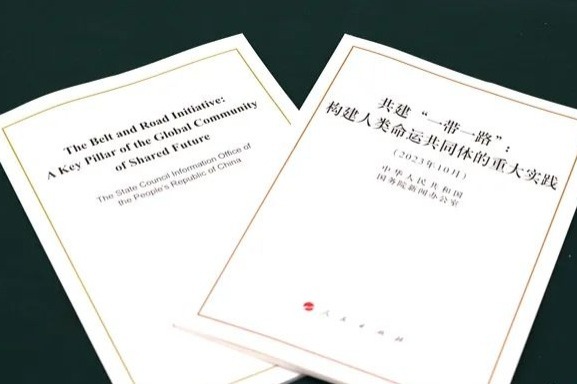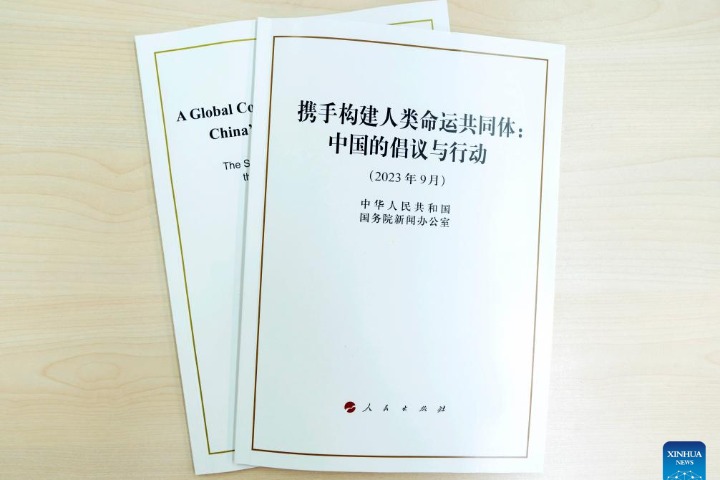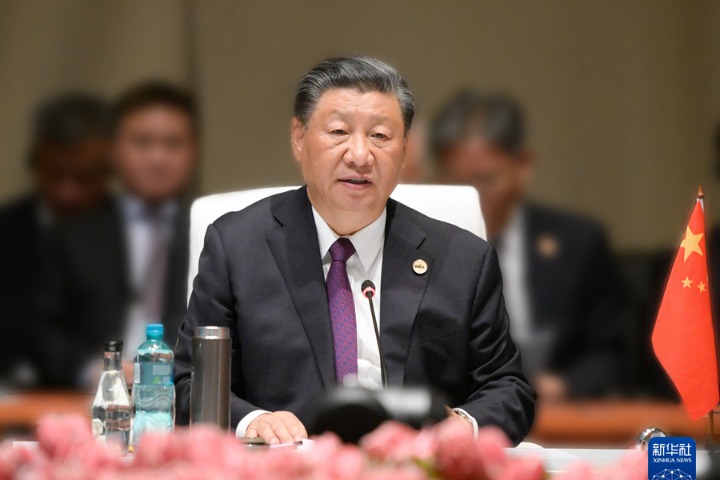《中国的核应急》白皮书双语全文
新华网 2016-01-27 10:24

三、核应急“一案三制”建设
III. All-round Promotion of Nuclear Emergency Preparedness
中国高度重视核应急的预案和法制、体制、机制(简称“一案三制”)建设,通过法律制度保障、体制机制保障,建立健全国家核应急组织管理体系。
China lays great store by the planning, and legislative/institutional/regulatory systems (known in Chinese as “One Planning plus Three Systems”) associated with nuclear emergency preparedness, and ensures the establishment and full functioning of a national nuclear emergency management system through the safeguards of legislation, institution and regulations.
加强全国核应急预案体系建设。《国家核应急预案》是中央政府应对处置核事故预先制定的工作方案。《国家核应急预案》对核应急准备与响应的组织体系、核应急指挥与协调机制、核事故应急响应分级、核事故后恢复行动、应急准备与保障措施等作了全面规定。按照《国家核应急预案》要求,各级政府部门和核设施营运单位制定核应急预案,形成相互配套衔接的全国核应急预案体系。
Strengthening national nuclear emergency planning system building. The National Nuclear Emergency Plan is an action program pre-set by the central government to cope with nuclear accident scenarios. The National Nuclear Emergency Plan lays down a whole set of regulations on the organizational system, command and coordination mechanism, emergency response classification, post-accident restoration actions, and emergency preparation and safeguard measures related to nuclear emergency preparation and response actions. In line with the requirements of the National Nuclear Emergency Plan, governments at all levels and nuclear installation operators must draw up nuclear emergency plans fully in keeping with the National Nuclear Emergency Plan, so as to form a nationwide system of nuclear emergency planning.
加强核应急法制建设。中国基本形成国家法律、行政法规、部门规章、国家和行业标准、管理导则于一体的核应急法律法规标准体系。早在1993年8月就颁布实施《核电厂核事故应急管理条例》。进入本世纪以来,又先后颁布实施《中华人民共和国放射性污染防治法》《中华人民共和国突发事件应对法》,从法律层面对核应急作出规定和要求。2015年7月,新修订的《中华人民共和国国家安全法》开始实施,进一步强调加强核事故应急体系和应急能力建设,防止、控制和消除核事故对公众生命健康和生态环境的危害。与这些法律法规相配套,政府相关部门制定相应的部门规章和管理导则,相关机构和涉核行业制定技术标准。军队制定参加核电厂核事故应急救援条例等相关法规和规章制度。目前,正积极推进原子能法、核安全法立法进程。
Strengthening nuclear emergency legislative system building. China has put in place its own nuclear emergency legal framework, comprising state laws, administrative regulations, departmental rules, national and industrial standards, and management guidelines. As early as August 1993 China put into effect the Regulations on Emergency Management of Nuclear Accidents at Nuclear Power Plants. Since the beginning of this century China has, in succession, enacted the Law of the People's Republic of China on Prevention and Control of Radioactive Pollution and Emergency Response Law of the People's Republic of China, providing regulations and requirements from the legal perspective on nuclear emergency preparedness. In July 2015 the newly revised State Security Law of the People's Republic of China was promulgated, further reinforcing the nuclear accident emergency system and emergency response capacity building to prevent, control and eliminate damage to the life and health of the general public and ecological environment. In keeping with the foregoing laws and regulations, relevant departments of the government have worked out and put into effect their respective regulations and management guidelines, and relevant institutions and nuclear-related industries have drawn up applicable technical standards. The military also has drawn up relevant regulations, and established systems governing emergency rescue actions associated with nuclear emergency preparedness. Currently efforts are being made to push forward the legislative process associated with the Atomic Energy Law and Nuclear Safety Law.
加强核应急管理体制建设。中国核应急实行国家统一领导、综合协调、分级负责、属地管理为主的管理体制。全国核应急管理工作由中央政府指定部门牵头负责。核设施所在地的省(区、市)人民政府指定部门负责本行政区域内的核应急管理工作。核设施营运单位及其上级主管部门(单位)负责场内核应急管理工作。必要时,由中央政府领导、组织、协调全国的核事故应急管理工作。
Strengthening nuclear emergency management system building. China implements a nuclear emergency management system featuring unified leadership at the national level, overall coordination, assignment of responsibilities to different levels and emphasis on localized administration. The nuclear emergency management is led and placed under the responsibility of the department designated by the central government. The governments of the province (autonomous region or centrally administered municipality) wherein nuclear installations are located are responsible for nuclear emergency management within their respective jurisdictions. The operator of the relevant nuclear installation and its senior competent authority (unit) shall be responsible for on-site emergency management. Wherever necessary, the central government will lead, organize and coordinate nuclear emergency management at the national level.
加强核应急机制建设。中国实行由一个部门牵头、多个部门参与的核应急组织协调机制。在国家层面,设立国家核事故应急协调委员会,由政府和军队相关部门组成,主要职责是:贯彻国家核应急工作方针,拟定国家核应急工作政策,统一协调全国核事故应急,决策、组织、指挥应急支援响应行动。同时设立国家核事故应急办公室,承担国家核事故应急协调委员会日常工作。在省(区、市)层面,设立核应急协调机构。核设施营运单位设立核应急组织。国家和各相关省(区、市)以及核设施营运单位建立专家委员会或支撑机构,为核应急准备与响应提供决策咨询和建议。
Strengthening nuclear emergency mechanism building. China implements a nuclear emergency organization and coordination mechanism featuring leadership by one department and participation by multiple departments. At the national level, a National Nuclear Accident Emergency Coordination Committee has been set up comprising relevant governmental and military departments with the following main responsibilities: implementing state nuclear emergency work guidelines, drawing up national policies for nuclear emergency management, uniformly coordinating emergency activities at the national level, and deciding, organizing and commanding emergency assistance response actions. A National Nuclear Emergency Office has also been set up to undertake the routine work of the National Nuclear Accident Emergency Coordination Committee. At the provincial (regional and municipal) levels, nuclear emergency coordination bodies have been established, and operators of nuclear installations have set up their respective nuclear emergency bodies. At the national and provincial (regional and municipal) levels and within the operators of the nuclear installations, committees of experts or the support organizations thereof have been established to provide advice and suggestions on nuclear emergency preparedness and response.
四、核应急能力建设与保持
IV. Building and Maintenance of Nuclear Emergency Capabilities
中国坚持积极兼容、资源整合、专业配套、军民融合的思路,建设并保持与核能事业安全高效发展相适应的国家核应急能力,形成有效应对核事故的国家核应急能力体系。
Sticking to the guidelines of versatile compatibility, resource integration, interdisciplinary support, and integration of military and civilian capabilities, China builds and maintains national nuclear emergency capabilities commensurate with the safe and efficient development of nuclear energy, and forms a fully-fledged national system of nuclear emergency response capabilities.
国家建立全国统一的核应急能力体系,部署军队和地方两个工作系统,区分国家级、省级、核设施营运单位级三个能力层次,推进核应急领域的各种力量建设。
At the national level, a unified nuclear emergency response capabilities system is in place to coordinate military and local systems whereby three distinct tiers of capabilities are maintained, viz. national, provincial and nuclear installation operator levels, with a view to pushing forward with the building of various capabilities related to nuclear emergency response.
建设国家核应急专业技术支持中心。建设辐射监测、辐射防护、航空监测、医学救援、海洋辐射监测、气象监测预报、辅助决策、响应行动等8类国家级核应急专业技术支持中心以及3个国家级核应急培训基地,基本形成专业齐全、功能完备、支撑有效的核应急技术支持和培训体系。
Building national nuclear emergency response professional technical support centers. China has built eight types of national-level nuclear emergency technical support centers, i.e., radiation monitoring, radiation prevention, aviation monitoring, medical rescue, marine radiation monitoring, meteorological monitoring and forecasting, decision-making aid, and response action, along with three national-level nuclear emergency response training bases, thereby essentially forming an integrated emergency technical support and training system featuring a full array of disciplines and functions, and effective support.
建设国家级核应急救援力量。经过多年努力,中国形成了规模适度、功能衔接、布局合理的核应急救援专业力量体系。适应核电站建设布局需要,按照区域部署、模块设置、专业配套原则,组建30余支国家级专业救援分队,承担核事故应急处置各类专业救援任务。军队是国家级核应急救援力量的重要组成部分,担负支援地方核事故应急的职责使命,近年来核应急力量建设成效显著。为应对可能发生的严重核事故,依托现有能力基础,中国将组建一支300余人的国家核应急救援队,主要承担复杂条件下重特大核事故突击抢险和紧急处置任务,并参与国际核应急救援行动。
Building national-level nuclear emergency rescue forces. Through efforts over many years, China has already built a specialized nuclear emergency rescue capability system that is of a proper scale, well-coordinated and of a rational layout. To cater to the needs of layout for the construction of nuclear power stations, on the principle of regional deployment, modular set-up and disciplinary integration, over 30 national-level professional rescue teams have been formed to specifically take charge of various kinds of specialized rescue missions. The military constitutes an important part of the national-level nuclear emergency rescue force, and fulfills the mission of aiding local nuclear accident emergency response actions, and, as such, has scored brilliant achievements in building up its nuclear emergency response capabilities. To cope with possible severe nuclear accidents and on the basis of the available capabilities, China is to form a national nuclear emergency rescue team composed of over 300 people to be mainly responsible for undertaking unexpected rescue missions in serious nuclear accident scenarios and emergency treatment tasks, and stand ready to take part in international nuclear emergency rescue operations.
建设省级核应急力量。中国设立核电站的省(区、市)均建立了相应的核应急力量,包括核应急指挥中心、应急辐射监测网、医学救治网、气象监测网、洗消点、撤离道路、撤离人员安置点等,以及专业技术支持能力和救援分队,基本满足本区域核应急准备与响应需要。省(区、市)核应急指挥中心与本级行政区域内核设施实现互联互通。
Building provincial-level nuclear emergency rescue forces. Nuclear emergency response forces have been established at the provincial (regional and municipal) levels in areas where nuclear power stations are sited, including nuclear emergency command centers, emergency radiation monitoring networks, medical treatment networks, meteorological monitoring networks, decontamination points, evacuation roads and shelters for evacuees, along with specialized technical support and rescue task forces, thereby basically meeting the nuclear emergency preparedness and response needs of the involved regions. Each provincial (regional and municipal) nuclear emergency command center is connected with the nuclear installation(s) within its jurisdiction.
建设核设施营运单位核应急力量。按照国家要求,参照国际标准,中国各核设施营运单位均建立相关的核应急设施及力量,包括应急指挥中心、应急通讯设施、应急监测和后果评价设施;配备应对处置紧急情况的应急电源等急需装备、设备和仪器;组建辐射监测、事故控制、去污洗消等场内核应急救援队伍。核设施营运单位所属涉核集团之间建立核应急相互支援合作机制,形成核应急资源储备和调配等支援能力,实现优势互补、相互协调。
Building a nuclear emergency response force on the part of the operators of nuclear installations. In accordance with national requirements and following international standards, operators of nuclear installations in China have set up their own nuclear emergency response facilities and forces, including emergency command centers, emergency communication facilities, and emergency monitoring and consequence evaluation facilities. In addition, emergency facilities, equipment and instrumentation, such as emergency power supply, are in place. On-site rescue teams specializing in radiation monitoring, accident control, decontamination and cleansing have been established. Corporations controlling operators of the respective nuclear installations have set up a mutual support collaborative mechanism to form nuclear emergency response resource reserve and deployment assistance capabilities, thereby ensuring mutually complementary support and coordination.
按照积极兼容原则,围绕各自职责,中国各级政府有关部门依据《国家核应急预案》明确的任务,分别建立并加强可服务保障核应急的能力体系。
In accordance with the principle of versatile compatibility and based on their respective duties and responsibilities, government departments at different levels in China have established and reinforced their respective capability systems to serve and safeguard nuclear emergency response activities commensurate with the tasks established under the National Nuclear Emergency Plan.
按照国家、相关省(区、市)和各核设施营运单位制定的核应急预案,在国家核应急体制机制框架下,各级各类核应急力量统一调配、联动使用,共同承担核事故应急处置任务。
In accordance with the nuclear emergency response plans worked out by the national and provincial (regional and municipal) authorities and the operators of nuclear installations and within the institutional framework of the national nuclear emergency response system, various levels and categories of nuclear emergency response forces ensure unified deployment and interactive mobilization to jointly undertake tasks associated with nuclear accident emergency situations.

















 英语点津微信
英语点津微信 双语小程序
双语小程序